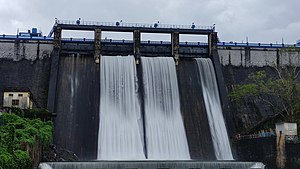
Dams have played an important role in supplying and storing water, particularly for large communities such as cities, and also for agriculture. However, they are now widely recognized as having many serious negative environmental, social and public health impacts:
- Trapping of sediment - this reduces sediment and nutrient flow down the river, with effects as far away as declining offshore fish stocks (as is reported with the Three Gorges DamW in China. This sediment also fills the dam, reducing its capacity.
- Interference with ecosystems including fish stocks. This is particularly the case where indigenous species are adapted to a cycle of wet and dry, as in Australian rivers - dams disrupt the cycle, and indigenous species lose their survival advantage over introduced species.
- Traditional farmers whose farming patterns depend on the natural cycle of the river can suffer. For example, in the Nile Valley, traditional farmers received irrigation and natural fertilizer from the annual floods, but after the Aswan DamW was built, they could not get the water without paying,[verification needed], and had to pay for fertilizer instead of receiving free nutrient-rich sediment deposited by the flood.
- Displacement of local people. Activists (including Arundhati RoyW[verification needed])alleged that poor people are frequently thrown off their land with no choice, and little or no compensation. For example, many indigenous Brazilians are opposed to the construction of the Belo Monte dam.[1]
- Diseases spread by water may be an issue. For example, the use of the Aswan Dam for agriculture removed the traditional dry period, allowing snails to survive, spread, and act as intermediate hosts[verification needed] for the schistosomiasisW pathogen, causing serious health problems to agricultural workers and others who had contact with the water.
These factors, and the fact that most suitable sites for dams have been dammed already, mean that other means of water supply are generally preferred. In some cases, old dams may actually be removed, or at least made to allow more water through (referred to as an environmental flowW).
Of course, many factors must be considered, and the needs of the community may be such that a dam is required. In this case, design is very important:
- If the dam is intended for hydroelectricity, use a "run of the river" design instead.
- Size no larger than necessary. This can be helped by emphasizing water efficiency in the community.
- Use of fish laddersW to minimize ecological impact. These should be designed for the local species.